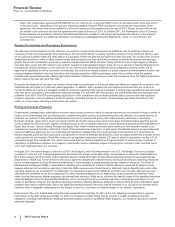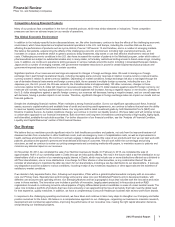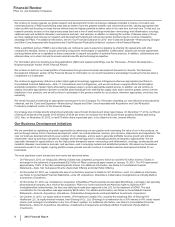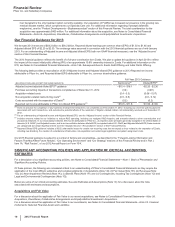Pfizer 2012 Annual Report Download - page 15
Download and view the complete annual report
Please find page 15 of the 2012 Pfizer annual report below. You can navigate through the pages in the report by either clicking on the pages listed below, or by using the keyword search tool below to find specific information within the annual report.
Financial Review
Pfizer Inc. and Subsidiary Companies
14
2012 Financial Report
and years of service. Also, on May 8, 2012, we announced to employees that as of January 1, 2018, Pfizer will transition its U.S. and Puerto
Rico employees from its defined benefit plans to an enhanced defined contribution savings plan.
The accounting for benefit plans is highly dependent on actuarial estimates, assumptions and calculations, which result from a complex series
of judgments about future events and uncertainties. The assumptions and actuarial estimates required to estimate the employee benefit
obligations for the defined benefit and postretirement plans may include the discount rate; expected salary increases; certain employee-related
factors, such as turnover, retirement age and mortality (life expectancy); expected return on assets; and healthcare cost trend rates.
Our assumptions reflect our historical experiences and our best judgment regarding future expectations that have been deemed reasonable by
management. The judgments made in determining the costs of our benefit plans can materially impact our results of operations.
The following table provides the expected versus actual rate of return on plan assets and the discount rate used to determine the benefit
obligations for the U.S. qualified pension plans:
2012 2011 2010
Expected annual rate of return 8.5% 8.5% 8.5%
Actual annual rate of return 12.7 3.4 10.8
Discount rate 4.3 5.1 5.9
The assumption for the expected rate of return on assets for our U.S. and international plans reflects our actual historical return experience
and our long-term assessment of forward-looking return expectations by asset classes, which is used to develop a weighted-average expected
return based on the implementation of our targeted asset allocation in our respective plans (see Notes to Consolidated Financial Statements—
Note 11D. Pension and Postretirement Benefit Plans and Defined Contribution Plans: Plan Assets for asset allocation ranges and actual asset
allocations for 2012 and 2011). The expected return for our U.S. plans and the majority of our international plans is applied to the fair market
value of plan assets at each year end. Holding all other assumptions constant, the effect of a 0.5 percentage-point decline in the return-on-
assets assumption would increase our 2013 U.S. qualified pension plans’ pre-tax expense by approximately $60 million.
The discount rate used in calculating our U.S. defined benefit plan obligations as of December 31, 2012 is 4.3%, which represents a 0.8
percentage-point decrease from our December 31, 2011 rate of 5.1%. The discount rate for our U.S. defined benefit plans is determined
annually and evaluated and modified to reflect at year-end the prevailing market rate of a portfolio of high-quality corporate bond investments
rated AA or better that would provide the future cash flows needed to settle benefit obligations as they come due. For our international plans,
the discount rates are set by benchmarking against investment grade corporate bonds rated AA or better, including where there is sufficient
data, a yield curve approach. These rate determinations are made consistent with local requirements. Holding all other assumptions constant,
the effect of a 0.1 percentage-point decrease in the discount rate assumption would increase our 2013 U.S. qualified pension plans’ pre-tax
expense by approximately $26 million and increase the U.S. qualified pension plans’ projected benefit obligations as of December 31, 2012 by
approximately $266 million.
Contingencies
For a discussion about income tax contingencies, see Notes to Consolidated Financial Statements—Note 5D. Tax Matters: Tax Contingencies.
For a discussion about legal and environmental contingencies, guarantees and indemnifications, see Notes to Consolidated Financial
Statements—Note 17. Commitments and Contingencies.
























